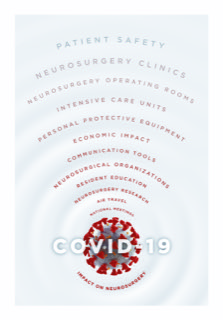Although the fields of emergency and critical care medicine, infectious diseases, virology, and epidemiology come more readily to mind when considering the battle against the virus known as SARS-CoV-2, neurosurgical practice has had to adapt swiftly in response to the COVID-19 pandemic.
Last week we heard from neurosurgeons in the United States, Canada, Italy, and China on the impact of the pandemic on neurosurgical practice. This week’s installment adds editorials from the Republic of Korea and Singapore.
The editorials cover a wide variety of important areas demonstrating the impact of COVID-19 on the practice and training of neurosurgeons. Here is a sampling of topics covered:
- Experiences of how various neurosurgical departments and personnel have faced the COVID-19 pandemic
- Creativity and innovation, decision making and priority setting
- Reassignment of staff to direct care of COVID-19 patients
- Task shifting and task sharing on the part of neurosurgical staff
- Guidance on reducing risks of viral exposure during endonasal surgeries
- Expanded use of telemedicine to temporarily replace neurosurgical clinic visits
- Shift to teleconferencing for clinical and research consultations and reporting, and for administrative and educational purposes
- Impact of the COVID-19 pandemic on neurosurgery resident training and education from both mentor and trainee points of view
- Alternative forms of neurosurgical training such as web-based tutorials, surgical simulation, and virtual reality
Join us in reading the following articles about neurosurgeons’ experiences and lessons learned thus far during the COVID-19 pandemic. All articles are free to the public.
Bambakidis NC, Tomei KL: Editorial. Impact of COVID-19 on neurosurgery resident training and education. Journal of Neurosurgery. https://thejns.org/doi/10.3171/2020.3.JNS20965
Bernstein M: Editorial. Neurosurgical priority setting during a pandemic: COVID-19. Journal of Neurosurgery. https://thejns.org/doi/10.3171/2020.4.JNS201031
Carter BS, Chiocca EA: Editorial. COVID-19 and academic neurosurgery. Journal of Neurosurgery. https://thejns.org/doi/10.3171/2020.4.JNS201013
Choi BD: Editorial. A neurosurgery resident’s response to COVID-19: anything but routine. Journal of Neurosurgery. https://thejns.org/doi/10.3171/2020.4.JNS201028
Ghogawala Z, Kurpad S, Falavigna A, Groff MW, Sciubba DM, Wu JC, Park P, Berven S, Hoh DJ, Bisson EF, Steinmetz MP, Wang MC, Chou D, Sansur CA, Smith JS, Tumialán LM: Editorial. COVID-19 and spinal surgery. Journal of Neurosurgery: Spine. https://thejns.org/doi/10.3171/2020.4.SPINE20468
Kim KH, Choi EH, Kim SK: Editorial. COVID-19 outbreak and its countermeasures in the Republic of Korea. Journal of Neurosurgery. https://thejns.org/doi/10.3171/2020.4.JNS201062
Lee ZD, Yeu DLC, Ang BT, Ng WH, Seow WT: Editorial. COVID-19 and its impact on neurosurgery: our early experience in Singapore. Journal of Neurosurgery. https://thejns.org/doi/10.3171/2020.4.JNS201026
Lo YT, Teo NWY, ANG BT: Editorial. Endonasal neurosurgery during the COVID-19 pandemic: the Singapore perspective. Journal of Neurosurgery. https://thejns.org/doi/10.3171/2020.4.JNS201036
Robertson FC, Lippa L, Broekman MLD: Editorial. Task shifting and task sharing for neurosurgeons amidst the COVID-19 pandemic. Journal of Neurosurgery. https://thejns.org/doi/10.3171/2020.4.JNS201056
Tomlinson SB, Hendricks BK, Cohen-Gadol AA: Editorial. Innovations in neurosurgical education during the COVID-19 pandemic: is it time to reexamine our neurosurgical training models? Journal of Neurosurgery. https://thejns.org/doi/10.3171/2020.4.JNS201012
Weiner HL, Adelson PD, Brockmeyer DL, Maher CO, Gupta N, Smyth MD, Jea A, Blount JP, Riva-Cambrin J, Lam SK, Ahn ES, Albert GW, Leonard JR: Editorial. Pediatric neurosurgery along with children’s hospitals’ innovations are rapid and uniform in response to the COVID-19 pandemic. Journal of Neurosurgery: Pediatrics. https://thejns.org/doi/10.3171/2020.4.PEDS20240
***
For additional information, please contact: Ms. Jo Ann M. Eliason, Communications Manager, Journal of Neurosurgery Publishing Group, One Morton Drive, Suite 200, Charlottesville, VA 22903. Email: [email protected]; Phone: 434-982-1209.
For 76 years, the Journal of Neurosurgery has been recognized by neurosurgeons and other medical specialists the world over for its authoritative clinical articles, cutting-edge laboratory research papers, renowned case reports, expert technical notes, and more. The Journal of Neurosurgery: Pediatrics focuses on diseases and disorders of the central nervous system and spine in children; the Journal of Neurosurgery: Spine focuses on neurosurgical approaches to the treatment of spinal diseases and disorders in adults. Both journals contain a variety of articles, including descriptions of preclinical and clinical research as well as case reports and technical notes. All three peer-reviewed journals are published monthly by the JNS Publishing Group, the scholarly journal division of the American Association of Neurological Surgeons. Other peer-reviewed journals published by the JNS Publishing Group include Neurosurgical Focus and Neurosurgical Focus: Video. All five journals can be accessed at www.thejns.org.
Founded in 1931 as the Harvey Cushing Society, the American Association of Neurological Surgeons (AANS) is a scientific and educational association with more than 10,000 members worldwide. The AANS is dedicated to advancing the specialty of neurological surgery in order to provide the highest quality of neurosurgical care to the public. All active members of the AANS are certified by the American Board of Neurological Surgery, the Royal College of Physicians and Surgeons (Neurosurgery) of Canada or the Mexican Council of Neurological Surgery, AC. Neurological surgery is the medical specialty concerned with the prevention, diagnosis, treatment, and rehabilitation of disorders that affect the entire nervous system including the brain, spinal column, spinal cord, and peripheral nerves. For more information, visit www.AANS.org.
Original post https://alertarticles.info


